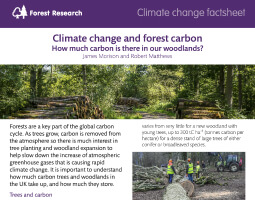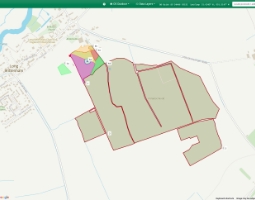Forest Carbon Cycle
Forests are a key part of the global carbon cycle. As trees grow, they remove carbon from the atmosphere. Therefore, there is much interest in the role that both existing and new forests can play in mitigating climate change and helping reach the UK commitment to achieve net zero greenhouse gas emissions by 2050.
The UK’s forests contain a lot of carbon: the National Forest Inventory estimates there are 3.1 million hectares of forest in the UK with a total carbon stock of around 250 million tonnes (MtC) in the trees and 1,095 MtC in the trees, deadwood, litter and soil of forests combined (Forest Research, 2023).
The UK’s forests also provide wood-based products; some of which can retain carbon for many years after being harvested from the forest. In 2022 the UK’s forests processed over 10 million green tonnes of softwood (92%) and hardwood (8%) into sawn timber, wood based panels, paper and paperboard, and wood fuel that is used in place of fossil fuels (Forestry Facts & Figures 2024).
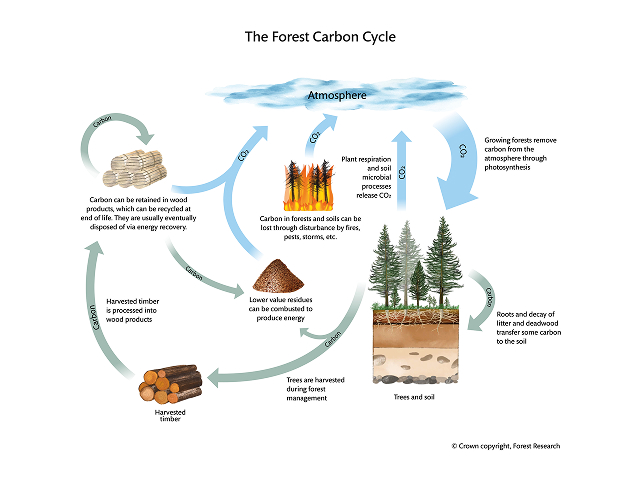
Click image to enlarge
Figure 1. Basic outline of the forest carbon cycle showing how forests provide a route to sequester carbon in land and soil, and that harvested wood products can be used to displace fossil fuels, and provide a long-term carbon store until they are disposed of. Forests and soils can also be disturbed by human behaviour or natural disturbance which can release stored carbon back to the atmosphere.
Forest Carbon Basics
Forest carbon stocks consist of several ‘pools’ of carbon:
- Tree biomass (above and below ground)
- Deadwood
- Litter
- Soil
The accumulation and retention of carbon within the trees, deadwood, litter and soil of a forest is a process called carbon sequestration.
Carbon is lost from forests through plant respiration, which releases CO2. Movement of tree material to the forest floor and belowground root activity transfers some carbon to the ground litter and the soil, where microbial decomposition processes also result in a substantial loss of CO2.
Outside the forest, carbon is retained in harvested wood-based products that are used in short-term uses such as paper, and longer-term uses like furniture, panel boards and structural timber.
At the end of life, wood can be recycled into other wood-based products (e.g., chipboard), until it is eventually disposed of, often to produce energy. Throughout this process, lower value wood residues can be used to generate energy and displace fossil fuels.
Tree Growth and Carbon
As trees grow, they remove carbon dioxide (CO2) from the atmosphere during photosynthesis and incorporate the carbon into their stems, branches, leaves and roots. Wood is approximately 50% carbon by weight. Within a single tree, typically, 50-65% of total carbon is found in the stem and 20-30% in the woody roots, with the rest in branches, foliage and fine roots. The total amount of carbon in a stand of trees is highly dependent on the age. Young trees will contain very little carbon, but a dense stand of large trees could reach up 1,100 tonnes carbon dioxide equivalent per hectare (tCO2e ha–¹).
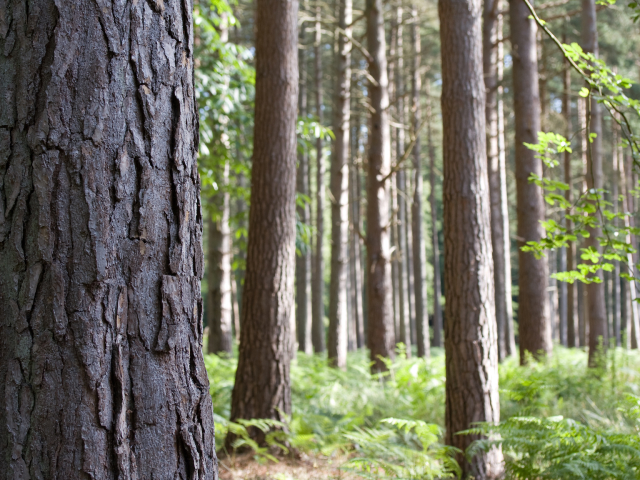
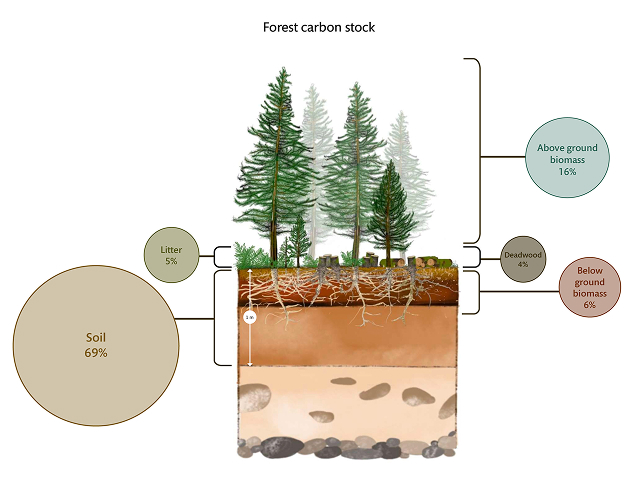
Click image to enlarge.
Figure 2. Illustration of the relative proportions of where carbon is stored in the forest, based on Forestry Statistics 2024.
Forest Carbon Stocks
In temperate climate zones, such as Britain, forest soils can contain as much carbon as the trees, and some soil types can contain considerably more. Mineral soils (sands and clays) typically contain 220-880 tCO2e ha-¹, and those with a high organic content, such as deep peat soils, can contain much more (up to 2,750 tCO2e ha-¹ in the top 1 m of the soil). Litter (fallen leaves, twigs, etc.) and deadwood also contain carbon and contribute to the forest carbon stock, but usually to a much lesser extent.
The forest carbon stock can be reduced through tree harvesting, which involves cutting down and removing some or all the trees in a stand. Trees may also be cut down for other purposes, such as creating open spaces for wildlife habitats. Usually, the carbon in harvested wood leaves the forest carbon stock and enters the wood-based products carbon pool where the carbon will be retained until the products are disposed of.
Harvesting trees also produces residues, such as poor-quality wood and branches that usually cannot be sold. Stumps and roots of harvested trees are usually left to decay. If material is left in the forest, it will decay at varying rates, with the carbon either entering the soil carbon pool or being released as CO2 (and sometimes as methane) through decay. Methane losses are usually much smaller than CO2 unless conditions are waterlogged and anaerobic.
Trees, and carbon, can also be lost through tree mortality, which can be caused by competition between growing trees, pests, diseases, drought, waterlogging, wind, fire, landslip and other erosion, or old age. The impacts on the forest carbon stock depend on the extent of tree and carbon loss and how much living and dead material is left after these various processes. Deadwood that remains in the forest will decay through time (over months to years), with the rate of carbon released to the atmosphere varying due to the local climate and soil, and other factors. Although disturbance is a natural phenomenon, and often a very important part of natural ecosystem function, disturbances can have negative impacts on the carbon stocks of forests, as well as incurring associated economic losses and ecosystem damage.
Overview
Forests play a crucial role in the sequestration and storage of carbon in land and providing us with useful wood products that can continue to retain carbon within it as trees are harvested and replanted.
Various factors can affect the rate of carbon sequestration in forests, including tree species, soil type, how forests are established, how they are managed, and how they are incorporated into landscapes (see our agroforestry page). There are various methods to assess how much carbon is contained in forests and how much they are removing (sequestering) from the atmosphere, as covered in the measuring forest carbon page.
While harvesting may result in a temporary loss of carbon stock from a forest, this can be consistent with sustainable forest management requirements (e.g. UK Forestry Standard), and it can provide wood-based products that can retain carbon for many years, or wood fuel that can reduce the need for fossil fuel combustion to provide energy
If left unmanaged, forests may become more susceptible to natural disturbance which can have significant negative carbon, biodiversity, and economic implications. Active management may also enable adaptation to the changing climate



